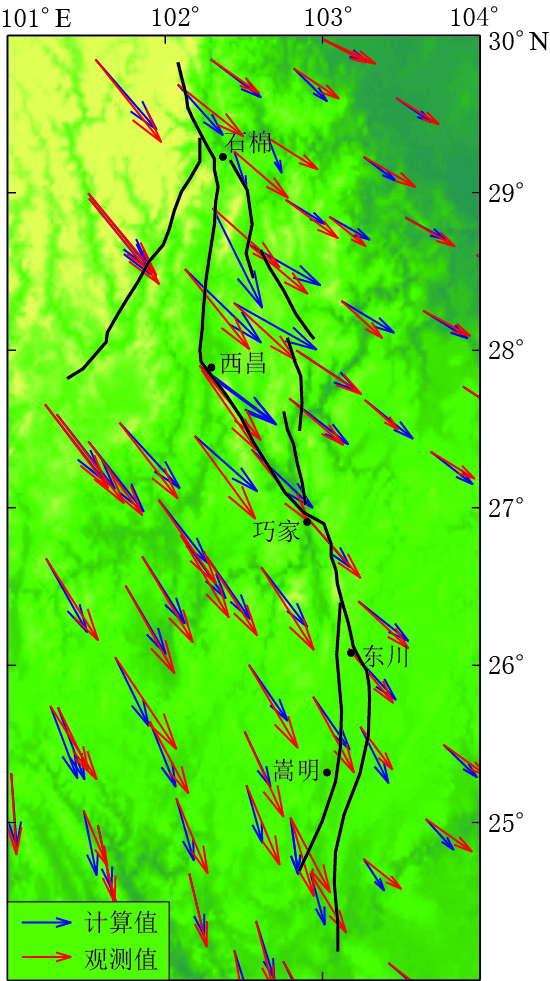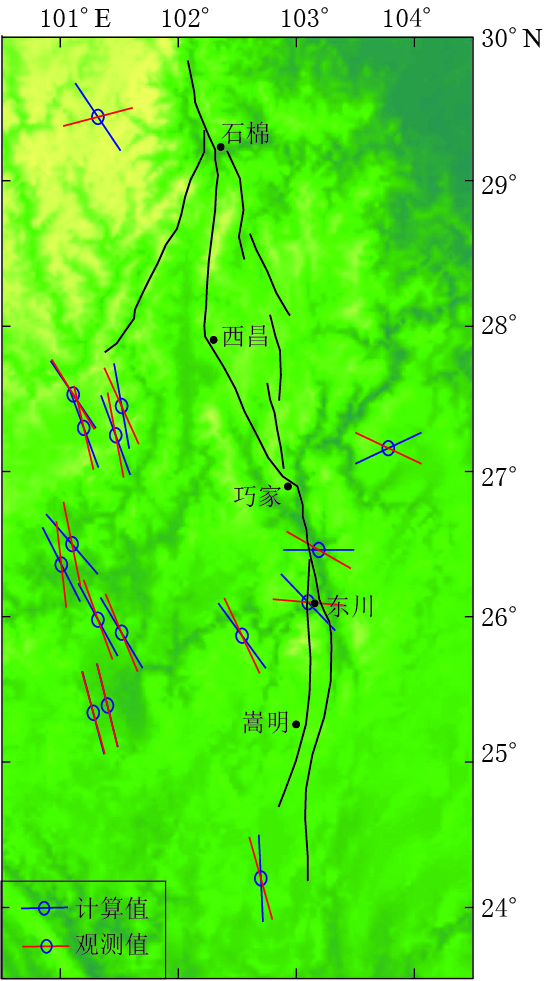Numerical simulation of the relationship between the tectonic stress distribution and the historical strong earthquake activities of the middle-southern segment of eastern boundary of the Sichuan-Yunnan block
-
摘要: 本文以构造应力场观测结果、 岩石圈流变特性为约束, 采用摩擦接触单元反映断裂带空间分段特征, 以最接近真实地下环境的非线性黏弹性材料为模型的本构关系, 建立包括安宁河—则木河—小江断裂带的三维有限元模型, 模拟在速度边界条件和重力势能等动力因素共同作用下的断裂带应力分布特性. 研究结果表明, 模拟得到的断裂带现今构造应力场与地震活动有明显的对应关系, 应力比较集中的区域, 如石棉、 西昌、 巧家、 东川附近, 极有可能是未来的地震危险区域.
-
关键词:
- 川滇地块东边界中南段 /
- 强震活动 /
- 黏弹性本构关系 /
- 库仑应力
Abstract: As the middle-southern segment of eastern boundary of Sichuan-Yunnan block, Anninghe-Zemuhe-Xiaojiang fault zone is very important to understand activities of strong earthquakes on the fault zone. This paper mainly focuses on the tectonic stress and the Coulomb stress caused by the earthquake rupture on the fault zone and their relationship with history strong earthquakes. Using different-size contact pairs to describe the spatial segment characteristic of the fault zone, and using the viscoelastic constitutive relation to discribe the different blocks, this paper establishes a three-dimensional finite-element model of the Anninghe-Zemuhe-Xiaojiang fault zone based on the latest data on crustal structure, seismotectonics, stress field, GPS, and rheology of the lithosphere. Considering the impact of the gravitational potential of the Qinghai-Xizang (Tibet) Plateau and the velocity boundary conditions, the stress distributon of the fault zones is obtained. The results indicate that the distribution of tectonic stress corresponds to activities of the strong earthquakes more obviously. And some places with tectonic stress concentration, such as Shimian, Xichang, Qiaojia, and Dongchuan, may be future seismic hazard areas. -
-
表 1 本文有限元模型的材料参数
Table 1 Material parameters of the finite element model built up in this paper
地层 华南地块 川滇地块 弹性模量 /(109Pa) 泊松比 黏滞系数 /(1021Pa 弹性模量 /(109 Pa) 泊松比 黏滞系数/(1021Pa 地表 90 0.25 2 80 0.25 1 上地壳 90 0.25 2 80 0.25 1 中地壳 100 0.30 500 90 0.30 100 下地壳 120 0.35 10 100 0.35 10 上地幔顶部 100 0.35 10 100 0.35 10 断层 10 0.49 1 10 0.49 1 软流圈 100 0.35 0.1 100 0.35 0.1 注:各地层的密度均为2 700 kg/m3. 表 2 安宁河—则木河—小江断裂带地区1327年以来发生的M≥6 ½地震
Table 2 TheM≥6 ½ earthquakes on Anninghe Zemuhe Xiaojiang fault zone since the year 1327
序号 年份 东经/° 北纬/° M 地点 1 1327 102.08 29.73 7 ½ 四川雅安 2 1480 102.21 28.86 7 ½ 四川岳西 3 1489 102.3 27.89 6 ¾ 四川西昌 4 1500 103.16 24.87 7 云南宜良 5 1536 102.19 28.23 7 ½ 四川西昌北 6 1713 103.24 25.47 6 ¾ 云南寻甸南 7 1725 103.04 25.13 6 ¾ 云南嵩明—宜良 8 1732 102.4 27.7 6 ¾ 四川西昌西南 9 1733 103.09 26.37 7 ¾ 云南东川 10 1786 102.04 29.87 7 四川泸定南 11 1789 102.96 24.29 7 云南华宁 12 1833 103 25.0 8 云南嵩明南 13 1850 102.53 27.37 7 ½ 四川西昌 14 1909 103.15 24.35 6 ½ 云南弥勒 15 1952 102.18 28.41 6 ¾ 四川冕宁南 16 1966 103.15 26.1 6 ½ 云南东川 表 3 安宁河—则木河—小江断裂带地区的库仑应力变化
Table 3 Variation of coulomb stress of Anninghe-Zemuhe-Xiaojiang fault zone
地震 第一列地震分别在各地震发生地点15 km深度处产生的库仑应力变化/MPa 1480年 M7 ½ 1489年 M6 ¾ 1500年M7 1536年M7 ½ 1713年M6 ¾ 1725年M6 ¾ 1732年M6 ¾ 1733年M7 ¾ 1786年M7 1789年M7 1833年M8 1850年M7 ½ 1909年M6 ½ 1952年M6 ¾ 1966年M6 ½ 1327年M7 ½ 0.0426 -0.0019 0 0.0077 -0.0006 0.0001 -0.0006 -0.0003 -0.7669 0 -0.0001 0.0001 0 0.0088 0.0002 1480年M7 ½ 0.0110 0 0.0513 -0.0003 -0.0001 0.0076 0 0.0043 0 0 0.0036 0 0.1019 0 1489年M6 ¾ 0 0.0201 -0.0006 0 -0.3705 -0.0009 0 0 -0.0003 0.0101 0 0.0061 0.0002 1500年M7 -0.0001 -0.0156 0.3632 0.0004 -0.0016 0 -0.0151 0.2323 0.0004 0.0231 0 0.0021 1536年M7 ½ -0.0007 -0.0009 -0.0491 -0.0015 0.0027 -0.0002 -0.0008 0.0894 0.0003 -0.0489 0.0003 1713年M6 ¾ 0.0293 0 -0.0057 0 -0.0003 -0.0059 0.0005 0.0018 -0.0001 0.0044 1725年M6 ¾ 0 -0.0029 0 -0.0088 1.2354 0.0006 0.0150 -0.0001 0.0039 1732年M6 ¾ -0.0009 0 0 -0.0002 0.0447 0 0.0044 0.0002 1733年M7 ¾ 0.0002 -0.0017 -0.0019 0.0066 0.0042 -0.0006 -0.2007 1786年M7 -0.0001 -0.0007 -0.0003 0.0002 0.0355 0.0004 1789年M7 -0.2677 0.0012 0.2404 0 0.0040 1833年M8 0.0049 0.2155 -0.0001 0.0354 1850年M7 ½ 0.0001 0.0149 0.0028 1909年M6 ½ 0 0.0001 1952年M6 ¾ 0 1966年M6 ½ 总计 0.0426 0.0091 0 0.0790 -0.0178 0.3916 -0.4122 -0.0138 -0.7597 -0.0262 1.1901 0.1618 0.5006 0.1218 -0.1467 -
安美建, 石耀霖. 2007. 中国大陆地壳和上地幔三维温度场[J]. 中国科学: D辑, 37(6): 736-745. An M J, Shi Y L. 2007. Three-dimensional thermal structure of the Chinese continental crust and upper mantle[J]. Science in China: Series D, 50(10): 1441-1451.
陈连旺, 张培震, 陆远忠, 陈化然, 马宏生, 李丽, 李红. 2008. 川滇地区强震序列库仑破裂应力加卸载效应的数值模拟[J]. 地球物理学报, 51(5): 1411-1421. Chen L W, Zhang P Z, Lu Y Z, Chen H R, Ma H S, Li L, Li H. 2008. Numerical simulation of loading/unloading effect on Coulomb failure stress among strong earthquakes in Sichuan-Yunnan area[J]. Chinese Journal of Geophysics, 51(5): 1411-1421 (in Chinese).
陈连旺, 詹自敏, 叶际阳, 李妍. 2011. 流变特性对青藏高原构造变形影响的数值模拟[J]. 大地测量与地球动力学, 31(3): 8-14. Chen L W, Zhan Z M, Ye J Y, Li Y. 2011. Numerically modeling the influence of rheological properties on tectonic deformation of Tibet Plateau[J]. Journal of Geodesy and Geodynamics, 31(3): 8-14 (in Chinese).
崔效锋, 谢富仁, 张红艳. 2006. 川滇地区现代构造应力场分区及动力学意义[J]. 地震学报, 28(5): 451-461. Cui X F, Xie F R, Zhang H Y. 2006. Recent tectonic stress field zoning in Sichuan-Yunnan region and its dynamic interest[J]. Acta Seismologica Sinica, 28(5): 451-461 (in Chinese).
邓起东, 张培震, 冉勇康, 杨晓平, 闵伟, 楚全芝. 2002. 中国活动构造基本特征[J]. 中国科学: D辑, 32(12): 1020-1031. Deng Q D, Zhang P Z, Ran Y K, Yang X P, Min W, Chu Q Z. 2002. Basic characteristics of active tectonics of China[J]. Science in China: Series D, 46(4): 356-372.
李玉江, 陈连旺, 李红. 2009. 云南地区构造应力应变场年变化特征的数值模拟[J]. 大地测量与地球动力学, 29(2): 13-18. Li Y J, Chen L W, Li H. 2009. Numerical simulation of annual change characteristics of tectonic stress-strain field in Yunnan area[J]. Journal of Geodesy and Geodynamics, 29(2): 13-18 (in Chinese).
石耀霖, 曹建玲. 2008. 中国大陆岩石圈等效粘滞系数的计算与讨论[J]. 地学前缘, 15(3): 82-95. Shi Y L, Cao J L. 2008. Effective viscosity of China continental lithosphere[J]. Earth Science Frontiers, 15(3): 82-95 (in Chinese).
石耀霖, 曹建玲. 2010. 库仑应力计算及应用过程中若干问题的讨论: 以汶川地震为例[J]. 地球物理学报, 53(1): 102-110. Shi Y L, Cao J L. 2010. Some aspects in static stress change calculation: Case study on Wenchuan earthquake[J]. Chinese Journal of Geophysics, 53(1): 102-110 (in Chinese).
王椿镛, 楼海, 吕智勇, 吴建平, 常利军, 戴仕贵, 尤惠川, 唐方头, Zhu L, Silver P. 2008. 青藏高原东部地壳上地幔S波速度结构: 下地壳流的深部环境[J]. 中国科学: D辑, 38(1): 22-32. Wang C Y, Lou H, Lü Z Y, Wu J P, Chang L J, Dai S G, You H C, Tang F T, Zhu L, Silver P. 2008. S-wave crustal and upper mantle's velocity structure in the eastern Tibetan Plateau: Deep environment of lower crustal flow[J]. Science in China: Series D, 51(2): 263-274.
王辉, 刘杰, 石耀霖, 张怀, 张国民. 2008. 鲜水河断裂带强震相互作用的动力学模拟研究[J]. 中国科学: D辑, 38(7): 808-818. Wang H, Liu J, Shi Y L, Zhang H, Zhang G M. 2008. Dynamic simulation of interactions between major earthquakes on the Xianshuihe fault zone[J]. Science in China: Series D, 51(10): 1388-1400.
王辉, 刘杰, 申旭辉, 刘勉, 李青松, 石耀霖, 张国民. 2010. 断层分布及几何形态对川西及邻区应变分配的影响[J]. 中国科学: 地球科学, 40(4): 458-472. Wang H, Liu J, Shen X H, Liu M, Li Q S, Shi Y L, Zhang G M. 2010. Influence of fault geometry and fault interaction on strain partitioning within western Sichuan and its adjacent region[J]. Science China: Earth Sciences, 53(7): 1056-1070.
王辉, 曹建玲, 荆燕, 李振. 2012. 川滇地区强震活动前b值的时空分布特征[J]. 地震地质, 34(3): 532-543. Wang H, Cao J L, Jing Y, Li Z. 2012. Spatio-temporal pattern of b-value before major earthquakes in the Sichuan-Yunnan region[J]. Seismology and Geology, 34(3): 532-543 (in Chinese).
王敏, 沈正康, 甘卫军, 廖华, 李铁明, 任金卫, 乔学军, 王庆良, 杨永林, 加藤照之, 李鹏. 2008. GPS连续监测鲜水河断裂形变场动态演化[J]. 中国科学: D辑, 38(5): 575-581. Wang M, Shen Z K, Gan W J, Liao H, Li T M, Ren J W, Qiao X J, Wang Q L, Yang Y L, Teruyuki K, Li P. 2008. GPS monitoring of temporal deformation of the Xianshuihe fault[J]. Science in China: Series D, 51(9): 1259-1266.
王琪, 张培震, 马宗晋. 2002. 中国大陆现今构造变形GPS观测数据与速度场[J]. 地学前缘, 9(2): 415-429. Wang Q, Zhang P Z, Ma Z J. 2002. GPS database and velocity field of contemporary tectonic deformation in continental China[J]. Earth Science Frontiers, 9(2): 415-429 (in Chinese).
闻学泽. 2000. 四川西部鲜水河-安宁河-则木河断裂带的地震破裂分段特征[J]. 地震地质, 22(3): 239-249. Wen X Z. 2000. Character of rupture segmentation of the Xianshuihe-Anninghe-Zemuhe fault zone, western Sichuan[J]. Seismology and Geology, 22(3): 239-249 (in Chinese).
闻学泽, 范军, 易桂喜, 邓一唯, 龙锋. 2008. 川西安宁河断裂上的地震空区[J]. 中国科学: D辑, 38(7): 797-807. Wen X Z, Fan J, Yi G X, Deng Y W, Long F. 2008. A seismic gap on the Anninghe fault in western Sichuan, China[J]. Science in China: Series D, 51(10): 1375-1387.
吴建平, 明跃红, 王椿镛. 2006. 川滇地区速度结构的区域地震波形反演研究[J]. 地球物理学报, 49(5): 1369-1376. Wu J P, Ming Y H, Wang C Y. 2006. Regional waveform inversion for crustal and upper mantle velocity structure below Chuan-Dian region[J]. Chinese Journal of Geophysics, 49(5): 1369-1376 (in Chinese).
许忠淮. 2001. 东亚地区现今构造应力图的编制[J]. 地震学报, 23(5): 492-501. Xu Z H. 2001. A present day tectonic stress map for Eastern Asia region[J]. Acta Seismologica Sinica, 23(5): 492-501 (in Chinese).
易桂喜, 闻学泽, 范军, 王思维. 2004. 由地震活动参数分析安宁河-则木河断裂带的现今活动习性及地震危险性[J]. 地震学报, 26(3): 294-303. Yi G X, Wen X Z, Fan J, Wang S W. 2004. Assessing current faulting behaviors and seismic risk of the Anninghe-Zemuhe fault zone from seismicity parameters[J]. Acta Seismologica Sinica, 26(3): 294-303 (in Chinese).
张东宁, 袁松涌, 沈正康. 2007. 青藏高原现代地壳运动与活动断裂带关系的模拟实验[J]. 地球物理学报, 50(1): 153-162. Zhang D N, Yuan S Y, Shen Z K. 2007. Numerical simulation of the recent crust movement and the fault activities in Tibetan Plateau[J]. Chinese Journal of Geophysics, 50(1): 153-162 (in Chinese).
张怀, 吴忠良, 张东宁, 刘杰, 王辉, 严珍珍, 石耀霖. 2009. 虚拟川滇: 基于千万网格并行有限元计算的区域强震演化过程数值模型设计和构建[J]. 中国科学: D辑, 39(3): 260-270. Zhang H, Wu Z L, Zhang D N, Liu J, Wang H, Yan Z Z, Shi Y L. 2009. Virtual ChuanDian: A parallel numerical modeling of Sichuan-Yunnan regional strong earthquake activities: Model construction and parallel simulation[J]. Science in China: Series D, 39(3): 260-270 (in Chinese).
张健, 石耀霖. 2002. 青藏高原隆升及伸展变形中的重力位能[J]. 地球物理学报, 45(2): 226-232. Zhang J, Shi Y L. 2002. The role of gravitational potential energy in raising and spreading of Qinghai-Xizang Plateau[J]. Chinese Journal of Geophysics, 45(2): 226-232 (in Chinese).
张培震, 邓起东, 张国民, 马瑾, 甘卫军, 闵伟, 毛凤英, 王琪. 2003. 中国大陆的强震活动与活动地块[J]. 中国科学: D辑, 33(增刊): 12-20. Zhang P Z, Deng Q D, Zhang G M, Ma J, Gan W J, Min W, Mao F Y, Wang Q. 2003. Active tectonic blocks and strong earthquakes in the continent of China[J]. Science in China: Series D, 46(Suppl): 13-24.
朱艾斓, 徐锡伟, 甘卫军, 陈桂华. 2009. 鲜水河-安宁河-则木河断裂带上可能存在的凹凸体: 来自背景地震活动性的证据[J]. 地学前缘, 16(1): 218-225. Zhu A L, Xu X W, Gan W J, Chen G H. 2009. The possible asperities on the Xianshuihe-Anninghe-Zemuhe fault zone: Evidence from background seismicity[J]. Earth Science Frontiers, 16(1): 218-225 (in Chinese).
祝爱玉, 张东宁. 2014. 重力等动力因素作用下安宁河-则木河-小江断裂带现今构造活动分段特征的数值模拟研究[C]//2014年中国地球科学联合学术年会论文集. 北京: 中国地球物理学会: 712-713. Zhu A Y, Zhang D N. 2014. Numerical simulation of the present activity characters of Anninghe-Zemuhe-Xiaojiang faults under gravity and other dynamic factors[C]//2014 Annual Meeting of the Chinese Academy of Earth Sciences. Beijing: Chinese Geophysical Society: 712-713 (in Chinese).
Harris R A. 1998. Introduction to special section: Stress triggers, stress shadows, and implications for seismic hazard[J]. J Geophys Res, 103(B10): 24347-24358.
Heidbach O, Tingay M, Barth A, Reinecker J, Kurfe D, Müller B. 2010. Global crustal stress pattern based on the World Stress Map database release 2008[J]. Tectonophysics, 482(1/2/3/4): 3-15.
Reasenberg P A, Simpson R W. 1992. Response of regional seismicity to the static stress change produced by the Loma Prieta earthquake[J]. Science, 255(5052): 1687-1690.
Stein R S, Barka A A, Dieterich J H. 1997. Progressive failure on the North Anatolian fault since 1939 by earthquake stress triggering[J]. Geophys J Int, 128(3): 594-604.
Stolk W, Kaban M, Beekman F, Tesauro M, Mooney W D, Cloetingh S. 2013. High resolution regional crustal models from irregularly distributed data: Application to Asia and adjacent areas[J]. Tectonophysics, 602: 55-68.
National Oceanic and Atmospheric Administration. 2014. ETOPO1[EB/OL]. [2014-12-20]. http://ngdc.noaa.gov/mgg/global/global.html.
Wen X Z, Ma S L, Xu X W. 2008. Historical pattern and behavior of earthquake ruptures along the eastern boundary of the Sichuan-Yunnan faulted-block, southwestern China[J]. Phys Earth Planet Inter, 168(1/2): 16-36.
Yang Y Q, Liu M. 2009. Crustal thickening and lateral extrusion during the Indo-Asian collision: A 3D viscous flow model[J]. Tectonophysics, 465(1/2/3/4): 128-135.





 下载:
下载:





